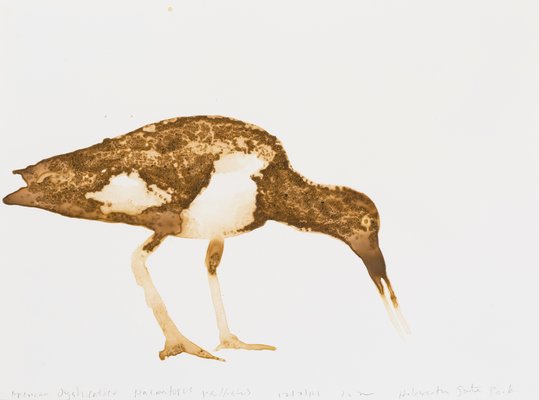
Alexis Rockman is more likely to hear about a beautiful day than experience one. The self-described shut-in passes most of his time brooding in his Manhattan studio, contemplating the world and painting epic oils of dystopian destruction and unbridled fantasy.But for two warm, rainy months in 2014, he left that world behind, trading it for open fields in Southampton, beaches in East Hampton, trails in Sag Harbor and parks in Montauk. He got his hands dirty—literally—by collecting mud, soil and leaves in plastic bags, and toting them back to his Sag Harbor rental, where he’s summered for a decade. There, he mixed them with water, dipped in his brush and began.
Out poured birds, plants, fish and turtles; insects, deer, seals and sharks. They swam, flew, waved in the breeze. And, for the first time ever, the 93 drawings Mr. Rockman created that summer are finally on view at none other than the Parrish Art Museum in Water Mill—after spending 10 months stowed away in a safe deposit box.
The “field drawings,” as Mr. Rockman calls them, have taken him to many corners of the world, he explained during a telephone interview on Monday from his home in Manhattan, and it was only a natural jump to try out the series in the Hamptons.
“I didn’t start these until ’94, when I was in the Amazon with some friends. We were joking around and so many of the great ideas you have are a joke at first,” he said. “It really sort of stuck. I grabbed a bunch of mud from this riverbank and that was the beginning.”
That first fistful of mud led to other projects in Tasmania, Madagascar, Guyana and Brazil. He even considered Antarctica—“and then I realized it would just be water,” he laughed. “It’s really hard to get soil there.”
With the guidance of naturalist Jim Ash, the former executive director of the South Fork Natural History Museum in Bridgehampton, Mr. Rockman said he learned the ins and outs of East End ecology in about three weeks before planning an itinerary.
For the next month, the artist visited five sites per day, gathering natural material in zip-lock bags—“sand, dirt, leaves, what have you,” he said—for each of his subjects, from flora to fauna.
When the time came, he would make three mixtures of differing viscosity from the materials—very concentrated, then medium and light—and, with water, make a drawing on paper. It felt primal and simple, he said, an art form dating back to cavemen.
“It’s a different muscle, though there are similar ways of immersing yourself in a world,” he said, comparing the field drawing series to his body of work. “This is very physical and the studio paintings I make are very cinematic and more immersive in a pictorial way.
“I love the limitations of the field drawings,” he added. “It’s like a sonnet. And the paintings are more like novels.”
Mr. Rockman, who is responsible for several concept paintings for the “Tiger Vision” scene in director Ang Lee’s “Life of Pi,” has seen his work on view in museums and galleries across the globe, and he has no shortage of projects. On Tuesday, a fossil expert and curator from the American Museum of Natural History took the artist through the five boroughs and New Jersey in order to gather fossil material, which will eventually become drawings of giant ferns that existed 360 million years ago, he said.
“Who wouldn’t want to do that?” he said, laughing. “I enjoy all of my field drawing experiences, all of them. It was all very memorable. Last summer, I got word from a friend who told me there was a beached leatherback turtle on Town Line Beach. It’s the largest turtle in the world. It was like seeing this incredibly beautiful, giant reptile. Unfortunately, it was dead and seagulls were eating its eyeballs.”
For most of his time in the field, it was raining, he said. But that didn’t dampen his spirits. One day, he found himself near Hook Pond in East Hampton—a “very human-disrupted environment,” he said.
“I got out of the car and walked over to the pond to grab some mud and saw the most beautiful white-tailed deer,” he recalled. “They’re horrible most of the time because you’re trying not to hit them, but he was drinking out of the pond and there was this beautiful symmetrical reflection in the water. It was a quiet moment of poetry.”
He considers his solitary life in the studio a sacrifice for his art, he said. “There are many times when I hear it was an incredible day,” he said. “This time, I could say myself that it was an incredible—but rainy—day.”
“Alexis Rockman: East End Field Drawings” will be on view through January 18 at the Parrish Art Museum in Water Mill. For more information, visit parrishart.org.